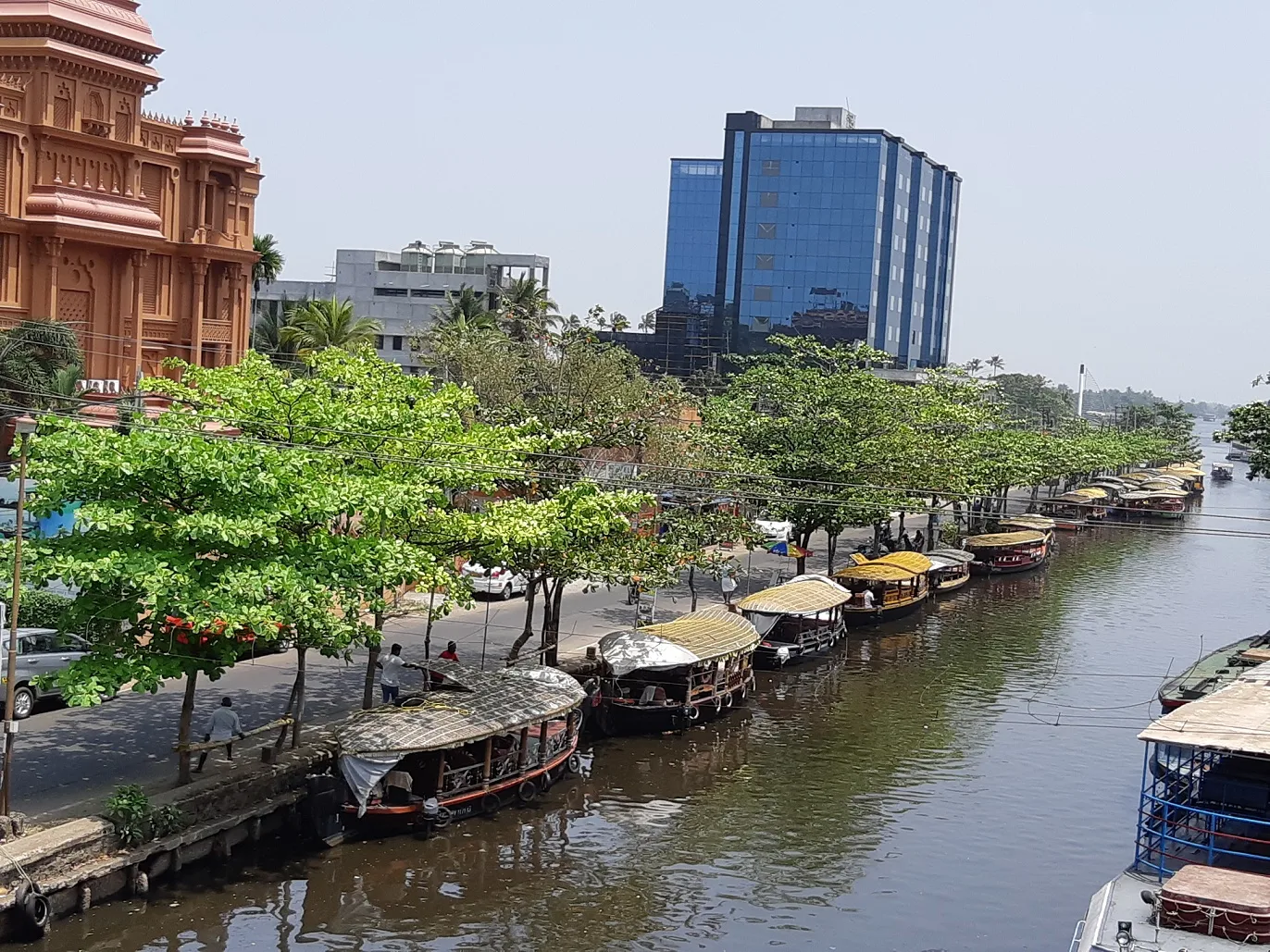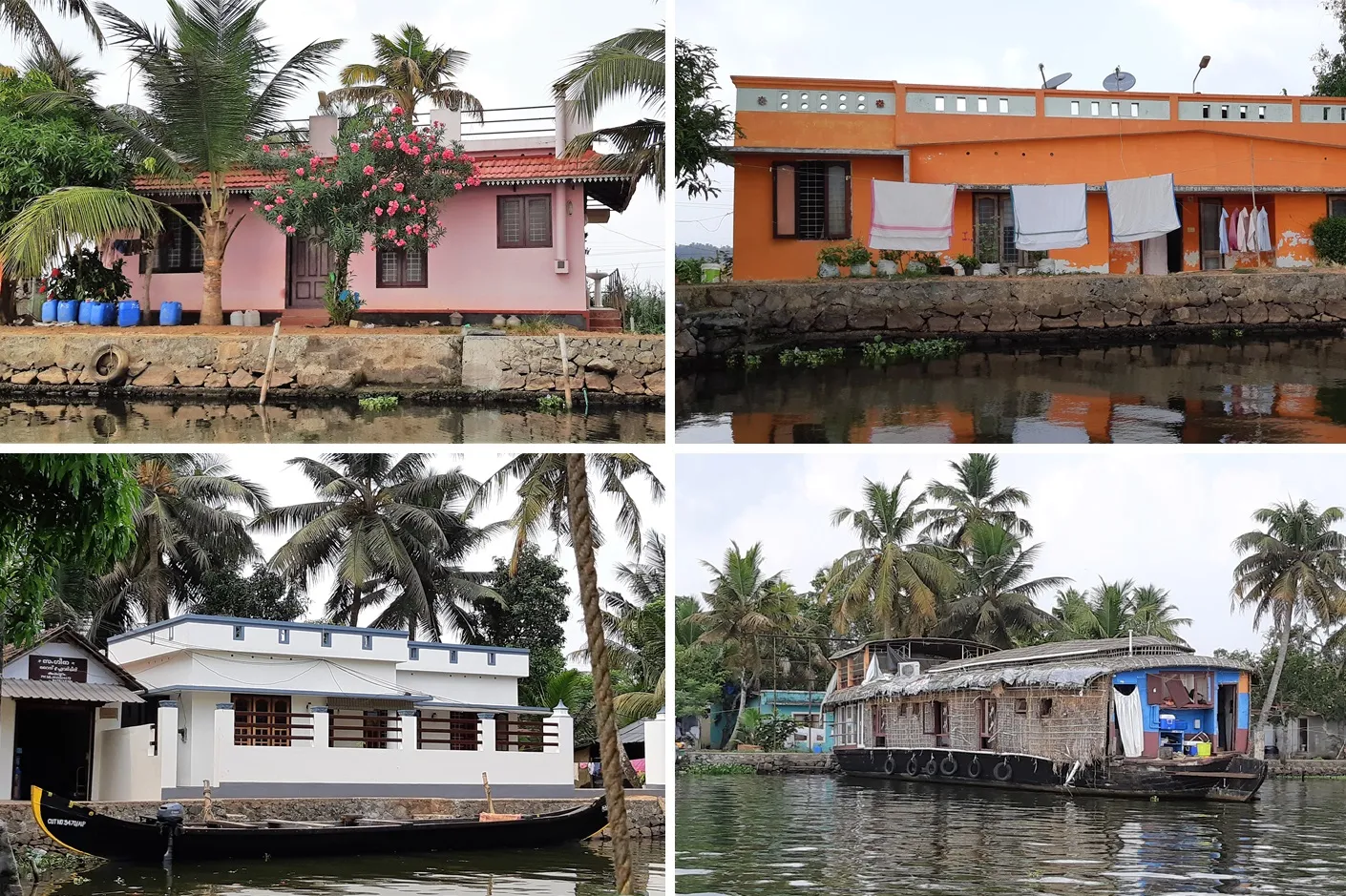After our lovely time in Chennai on India's east coast, we were now on an express train, travelling right across the bottom of India to Alleppey, which is on the west coast.
 |
| Fisherpeople, as seen from our train |
The train, the overnight Alleppey Express, left on time at 9:05 pm with us safely ensconced in our seats that turned into beds. They have to be the hardest beds ever, but we were still able to get some sleep. We even managed to get up in time to see some of the scenery, people fishing, plenty of birds, and lots of sea water.
We spent the last 20 minutes of our ride, chatting to an interesting man who worked on the train. He helped us get our bags off and we expected to see his hand out for a tip - but no - he was just being friendly. A nice surprise in this tip-demanding country.
Once in Alleppey (also called Alappuzha), it was a quick tuktuk ride to our lovely clean homestay accommodation, called Venice Castle.
 |
| Alleppey waterway seen from one of the town bridges |
Alleppey is in Kerala State. It sits on a small strip of land surrounded by a network of rivers, canals, and lagoons called backwaters, earning it the title of ‘Venice of the East’.
After dropping our gear at the homestay, we took a walk around Alleppey and its main canal. The town is not terribly big but the heat was terribly high (35 degrees Celsius), so we were soon heading back to our air-conditioned homestay room.
 |
| Marg at Alleppey beach on the Arabian Sea |
But the evening was gorgeous and much cooler, so we found a tuktuk to take us to Alleppey beach on the Arabian Sea, to watch the sunset. It’s a big wide sandy beach, and was full of people playing cricket and soccer, or just sitting waiting for the sun to go down. We attracted quite a bit of attention because we seemed to be the only people there with white skin.
The next morning, we went for a cruise in a shikara.
 |
| Above: A shikara boat. Below: Marg enjoying our trip in one |
This is a small wooden boat that has carved wooden pillars supporting a bamboo roof, powered by a wee outboard engine. Shikaras are based on the traditional fishing boats of Kerala. However, now-days they are set up for tourists.
It was a fabulous five hours. We had the whole boat to ourselves and enjoyed the cool breezes off the water in our open-sided shikara.
As we put-putted slowly through the backwaters, we had a great view of how the local people live.
 |
| Houses along a backwater canal, Alleppey |
We passed quite big modern houses, simple and small houses, churches, resorts, shops and cafes, all built along the waterways, and almost all with a canoe or two docked out front. In many cases the house was a boat.
The houses and buildings are surrounded by water, and are constantly at risk from floods in the monsoon season. On some, you can see the flood tide-mark half way up the wall.
 |
| Washing clothes and dishes in the canal water |
The canal waters are used for everything. We saw many women washing clothes and dishes on the banks, men bathing, and kids swimming and fishing.
The local people also use the canals and backwater routes as their road. They are a lifeline for the many tiny communities that live there.
 |
| Examples of the many types of boats on the backwaters of Alleppey |
And of course, there were a huge number of boats, either on the water or moored.
One interesting boat is called a kettuvalam or houseboat. They are traditional boats, bigger than the shikaras, and decked out as a hotel room for overnight cruising by tourists. We saw several on the bigger canals.
At the time we were there, the rice paddy fields were being harvested using big machines. The rice was then put directly into sacks to be loaded onto large canoes.
 |
| Rice being loaded onto large canoes |
The men load it manually carrying the big sacks on their heads. One group of men had finished loading when the ice cream man arrived in his boat. He seemed very popular!
The breeze was cool on the water, a welcome relief from the heat. Off the water hours later, we were glad to get back to our homestay and the welcome air-con.
A few days later after a wonderful stay n Alleppey, we headed to Kochi and the next part of our journey.
To get from Alleppey to Kochi, we hired a tuktuk. Our fantastic and knowledgeable driver Afzal (cell +919946541714), was lovely and full of information.
 |
| Village people between Alleppey and Kochi |
Instead of driving us along the main highway from Alleppey to Kochi, he took us along the small coastal road, passing through many tiny villages and doing some sightseeing on the way. It was so interesting.
We were taken to a local Hindu temple, then we stopped at a coir cooperative where we saw people making coir mats. Although the work looked difficult and hard on the hands, all the workers gave us a huge smile, happy to show us their skills.
 |
| Workers at the coir mat factory near Alleppey |
The women turn the fibre from coconut husk, into a coarse twine by hand. It is then dyed with primary colours before being passed over to the men to weave coir mats.
Alleppey and Kochi are in Kerala State, and this part of the state is apparently a holiday destination for city-based Indians. So, we passed many large wealthy looking houses, as well as lots of smaller, and really poor ones.
The beauty of the Kerala area has been admired by the Arabs, British, Dutch, Chinese, and Portuguese over time. As a result, the area is fascinatingly different to other parts of India.
 |
| A small range of the many Kochi Catholic churches |
The many Catholic churches along the route are a legacy of the Portuguese occupation. We saw one with a modern church at the front while the back part was a very attractive white historic Portuguese style church. There was also a range of Hindu temples.
Further along the coast, we came upon a group of fishermen unloading their catch. The sea off Kerala is well-known for its high fish yield caught by traditional methods.
 |
| Fishermen along the Alleppey to Kochi coast |
We learned that some fishermen go out in very small one-man boats close to the beach, while bigger brightly painted boats go further out to sea.
Our tuktuk trip took us past many inlets and small piers where hundreds of colourful boats were tied up, ready for the next morning’s fishing excursion.
We also passed fishing nets that hang on a frame so they can be lowered down into the water then lifted out, hopefully full of fish.
 |
| Chinese fishing nets |
They are called ‘Chinese fishing nets’ as it is believed they were introduced by the Chinese.
Further on, our tuktuk driver Afzal, showed us a cashew nut tree. The tree has fruit that can be eaten, and the cashew nut grows on one end of the fruit. We've eaten plenty of cashews, but never seen them growing or seen the fruit, so found it very interesting.
We stopped at a boat building enterprise where a group of men were building fishing boats from scratch. They had a number on the go, all in different stages of construction.
 |
| Hand stitched fishing boats |
They use planks of wood which were sort of stitched together, then sealed with coconut fibre before the next plank was added. We saw an almost-finished one that was beautiful.
After an interesting and event-filled trip, we arrived in Kochi, also known as Cochin and also called 'the Queen of the Arabian Sea' because of its role as an important spice trading centre from the 14th century onwards.
Kochi is now the financial, commercial and industrial capital of Kerala State. It is huge, with most of the large commercial enterprises being on the mainland and known as Ernakulam. But we stayed in the water-bound Fort area, which is a fishing town on the Arabian Sea.
 |
| The day's catch being auctioned on the beach |
Later, we walked down to the seafront and saw lots of fishermen bringing in their catch to sell. The fish were laid out on the ground, and people would inspect them and select what they wanted, then barter hard before completing the purchase. Buyers seemed to be almost always men.
There were a lot more Chinese fishing nets there. We also saw men wading chest-high in the sea to fish. Each would artfully swing his net around his head before throwing it, then hauling in his catch.
 |
| Princess St Kochi |
We loved the historic areas of Kochi and visited ancient churches, temples and a wide variety of shops, businesses, and houses. We spent time at the old Fort Emmanuel and the nearby beach, and visited many of the surrounding sights. We also enjoyed several wonderful seafood meals in Kochi.
On one occasion, went to neighbouring Mattanchery. Our first stop there was the Dutch Palace built by the Portuguese, and presented to the Raja of Kochi in 1555. It was then renovated by the Dutch in 1663. It is not a grand Palace, but was interesting to visit.
 |
| Jew Town, Mattanchery, Kochi |
Also in Mattanchery, we wandered around an area called Jew Town. There were some interesting old buildings, but all the shops were very touristy.
Then we visited the Paradesi Synagogue. Built in 1568, it is the oldest synagogue in the Commonwealth of Nations that is still in use. It was built for the community of Jewish people in Kochi, who were mostly refugees from the oppression of Jews in Portugal.
 |
| Spices spread out to dry at the spice market |
After that, we hired a tuktuk to show us more of Mattanchery, and one of our stops was at a spice market that had an amazing range of different spices. Kochi is still playing a role in the spice trade.
Eventually, and after a great time in this part of India, it was time to move on. Having come down the east coast of India, and crossed to the west, we now head north, with our next destination being Goa.
The above blog is part of our 2-month tour of India. The first blog on this tour is called “Off to Delhi".